Improving Efficiency of Passive RFID Tag Anti-Collision Protocol Using Dynamic Frame Adjustment and Optimal Splitting
Abstract
:1. Introduction
- We utilize dynamic frame adjustment and optimal splitting in the proposed algorithm (DFA-OS) to improve the efficiency performances of the passive RFID tag anti-collision protocol.
- The dynamic frame adjustment method would adjust the length of a frame to make it closer to a value that corresponds to the quantity of tags to yield optimal efficiency, which is better than existing protocols, such as dynamic BTSA (DBTSA).
- The proposed algorithm is a non-estimation-based protocol, meaning that the efficiency of the protocol is constant when the quantity of tags increases.
- The optimal splitting method is conceived with a smaller time duration for idle slots, making it outperform binary splitting protocol.
- Dynamic frame adjustment and optimal splitting (DFA-OS) are applied together in a way that is different from existing non-estimation-based protocols that have been proposed based on improved frame adjustment method, such as DBTSA, in conjunction with the optimal splitting scheme.
- The efficiency of the proposed algorithm is achieved through reducing the number of idle slots as well as identification time compared to existing protocols, such as a DBTSA, adoptive BTSA and splitting BTSA that only proposed to reduce the number of collisions.
2. Related Work
3. Preliminaries
3.1. Conventional Algorithm
3.2. Dynamic BTSA (DBTSA)
3.3. Performance of Existing Tag Anti-Collision Schemes
4. The Proposed DAF-OS Algorithm
4.1. The Splitting Algorithm
4.2. Fun: OS(L)
| Algorithm 1. Pseudo code of DFA-OS: reader side |
| 1 Q = 4.0 |
| 2 Dynamic BTSA |
| function Dynamic BTSA |
| 3 send adjustment command with |
| 4 get answer of transponder |
| 5 if transponder collision |
| 6 then and Dy: |
| 7 else if idle answer |
| 8 and Dy: |
| 9 else if successful answer |
| 10 BTSA |
| function BTSA (L) |
| 11 transmit command with Length and c = 0 |
| 12 do {take transponder answer and find collision |
| if transponder collision |
| 13 Send feedback = collision and perform Fun: OS() } |
| 14 else if no answer |
| 15 send feedback = idle |
| 16 else transponder answer |
| 17 take ID by transponder and reply = successful |
| 18 end |
| 19 while |
| function OS (L) |
| 20 Initial transmit active message |
| 21 take answer by transponder |
| 22 loop if reply collisional |
| 23 transmit and run algorithm |
| 24 else if iteration |
| 25 then transmit and run algorithm |
| 26 if reply idle |
| 27 then transmit |
| 28 else if successful |
| 29 then transmit |
| 30 end loop |
| 31 when no more answer |
| 32 transmit inactive message |
| Algorithm 2. Pseudo code of DFA-OS: tag side |
| 1 starting counter c = 0 |
| 2 while set command with |
| 3 do {c = 0 to |
| 4 if c = 0 send id end } |
| 5 if take command with |
| 6 c = 0 to |
| 7 while c ≥ 0 |
| 8 do {c = transponder find (counter) } |
| function id () |
| 9 starting count c = 0 |
| 10 loop when c ≥ 0 |
| 11 (c = 0) transponder answer |
| 12 transponder receive feedback message r |
| 13 do |
| 14 if r = 0 or 1: (c ≥ 0) transponder |
| 15 do |
| 16 if r = 2 (c = 0) transponder |
| 17 do c = c + q |
| 18 else do i = i + 1 when iteration |
| 19 end loop when c < 0 |
4.3. Fun: DBTSA(L)
5. Experiment and Analysis
6. Conclusions
Acknowledgments
Author Contributions
Conflicts of Interest
References
- Marcelo, C.A.; Cesam, A.M.M.; Fabiano, P.H. Survey of standardized ISO 180 0 0-6 RFID anti-collision protocols. In Proceedings of the Second International Conference on Sensor Technologies and Applications (SENSORCOMM-2008), Cap Esterel, France, 25–31 August 2008; pp. 468–473. [Google Scholar]
- Ray, Y.Z.; Dai, Q.Y.; Qu, T.; Hu, G.J.; George, Q.H. RFID-enabled real-time Manufacturing execution system for mass-customization production. Robot. Comput. Integr. Manuf. 2013, 29, 283–292. [Google Scholar]
- Wang, D.; Hu, J.; Tan, H.-Z. A highly stable and reliable 13.56-MHz RFID tag IC for contactless payment. IEEE Trans. Ind. Electron. 2015, 62, 545–554. [Google Scholar] [CrossRef]
- Yuan, C.L.; Chih, C.L. Two couple-resolution blocking protocols on adaptive query splitting for RFID tag identification. IEEE Trans. Mob. Comput. 2012, 11, 1450–1463. [Google Scholar]
- Javier, V.-A.; Victoria, B.-D.; Esteban, E.-L.; Francisco, J.G.-C.; Juan, A. Multi-frame maximum-likelihood tag estimation for RFID anti-collision protocols. IEEE Trans. Ind. Inform. 2011, 7, 487–496. [Google Scholar]
- Harald, V. Efficient object identification with passive RFID tags. In Proceedings of the First International Conference on Pervasive Computing, part of Lecture Notes in Computer Science, Zürich, Switzerland, 26–28 August 2002; Springer: Berlin/Heidelberg, Germany, 2002; Volume 2414, pp. 98–113. [Google Scholar]
- Shin, J.-D.; Yeo, S.-S.; Kim, T.-H.; Kim, S.-K. Hybrid tag anti-collision algorithms in RFID systems. In Proceedings of the 7th International Conference on Computational Science—ICCS-07, Beijing, China, 27–30 May 2007; pp. 693–700. [Google Scholar]
- Klaus, F. RFlD Handbook: Fundamentals and Applications in Contactless Smart Cards and Identification, 2nd ed.; John Wiley & Sons: Chichester, UK, 2003. [Google Scholar]
- Klair, D.K.; Chin, K.-W.; Raad, R. A survey and tutorial of RFID anti-collision protocols. IEEE Commun. Surv. Tutor. 2010, 12, 400–421. [Google Scholar] [CrossRef]
- Wu, H.; Zeng, Y.; Feng, J.; Gu, Y. Binary tree slotted aloha for passive RFID tag anti-collision. IEEE Trans. Parallel Distrib. Syst. 2013, 24, 19–31. [Google Scholar] [CrossRef]
- Murali, S.K.; Thyaga, N. Fast and reliable estimation schemes in RFID systems. In Proceedings of the 12th International Conference on Mobile Computing and Networking, Los Angeles, CA, USA, 23–29 September 2006; ACM: New York, NY, USA, 2006; pp. 322–333. [Google Scholar]
- Wu, H.; Zeng, Y. Efficient framed slotted aloha protocol for RFID tag anti-collision. IEEE Trans. Autom. Sci. Eng. 2011, 8, 581–588. [Google Scholar] [CrossRef]
- Chen, W.-T. An accurate tag estimate method for improving the performance of an RFID anti-collision algorithm based on dynamic frame length ALOHA. IEEE Trans. Autom. Sci. Eng. 2009, 6, 9–15. [Google Scholar] [CrossRef]
- Wu, H.; Zeng, Y. Bayesian tag estimate and optimal frame length for anti-collision ALOHA RFID system. IEEE Trans. Autom. Sci. Eng. 2010, 7, 963–969. [Google Scholar] [CrossRef]
- Qian, C.; Liu, Y.; Ngan, H.; Ni, L.M. ASAP: Scalable identification and counting for contactless RFID systems. In Proceedings of the International Conference of Distributed Computing Systems (ICDCS ’10), Genova, Italy, 21–25 June 2010; pp. 52–61. [Google Scholar]
- Zeng, Y.; Li, M.; Qian, C. PET: Probabilistic estimating tree for large-scale RFID estimation. In Proceedings of the 31st International Conference Distributed Computing Systems (ICDCS), Minneapolis, MN, USA, 20–24 June 2011; pp. 37–46. [Google Scholar]
- Lee, S.-R.; Joo, S.-D.; Lee, C.-W. An enhanced dynamic framed aloha algorithm for RFID tag identification. In Proceedings of the 2nd International Conference on Mobile and Ubiquitous Systems: Networking and Services, San Diego, CA, USA, 17–21 July 2005; pp. 1–5. [Google Scholar]
- Bonuccelli, M.A.; Lonetti, F.; Martelli, F. Tree slotted ALOHA: A new protocol for tag identification in RFID Networks. In Proceedings of the International Symposium on World of Wireless, Mobile and Multimedia Networks, Buffalo-Niagara Falls, NY, USA, 26–29 June 2006; pp. 1–6. [Google Scholar]
- Guo, H.; Leung, V.C.M.; Bolic, M. M-ary RFID tags splitting with small idle slots. IEEE Trans. Autom. Sci. Eng. 2012, 9, 177–181. [Google Scholar] [CrossRef]
- Miodrag, B.; David, S.-R.; Ivan, S. RFID: System Research Trends and Challenges, 1st ed.; John Wiley & Sons: Hoboken, NJ, USA, 2010; pp. 181–228. [Google Scholar]
- Qian, C.; Ngan, H.; Liu, Y.; Ni, L.M. Cardinality estimation for large-scale RFID systems, parallel and distributed systems. IEEE Trans. Parallel Distrib. Syst. 2011, 22, 1441–1454. [Google Scholar] [CrossRef]
- Cmiljanic, N.; Landaluce, H.; Perallos, A.; Arjona, L. Influence of the distribution of Tag IDs on RFID memoryless anti-collision protocols. Sensors 2017, 17, 1891. [Google Scholar] [CrossRef] [PubMed]
- Duan, L.; Pang, W.; Duan, F. An enhance posterior probability anti-collision algorithm based on dynamic frame slotted ALOHA. J. Commun. 2014, 9, 798–804. [Google Scholar] [CrossRef]
- Maselli, G.; Petrioli, C.; Vicari, C. Dynamic tag estimation for optimizing tree slotted ALOHA in RFID networks. In Proceedings of the 11th International Symposium on Modeling, Analysis and Simulation of Wireless and Mobile Systems, Vancouver, BC, Canada, 27–31 October 2008; ACM: New York, NY, USA, 2008; pp. 315–322. [Google Scholar]
- Tsai, S.-C.; Hu, Y.-M.; Chai, C.-H.; Li, J.-S. Efficient tag reading protocol for large-scale RFID systems with pre-reading. Comput. Commun. 2016, 88, 73–83. [Google Scholar] [CrossRef]
- Cui, Y.; Zhao, Y. A modified q-parameter anti-collision scheme for RFID systems. In Proceedings of the International Conference on Ultra Model Telecommunications and Workshop, St. Petersburg, Russia, 12–14 October 2009; pp. 1–4. [Google Scholar]
- Park, J.; Chung, M.Y.; Lee, T.-J. Identification of RFID tags in framed-slotted ALOHA with robust estimation and binary selection. IEEE Commun. Lett. 2007, 11, 452–454. [Google Scholar] [CrossRef]
- Myung, J.; Lee, W.; Srivastava, J.; Shih, T.K. Tag-splitting: Adaptive collision arbitration protocols for RFID tag identification. IEEE Trans. Parallel Distrib. Syst. 2007, 18, 763–775. [Google Scholar] [CrossRef]
- Deng, D.-J.; Tsao, H.-W. Optimal dynamic framed slotted ALOHA based anti-collision algorithm for RFID systems. Wirel. Pers. Commun. 2011, 59, 109–122. [Google Scholar] [CrossRef]
- Zheng, F.; Kaiser, T. Adaptive aloha anti-collision algorithms for RFID systems. EURASIP J. Embed. Syst. 2016, 7, 1–14. [Google Scholar] [CrossRef]
- He, Y.; Wang, X. An aloha-based improved anti-collision Algorithm for RFID systems. IEEE Wirel. Commun. 2013, 20, 152–158. [Google Scholar]
- Xu, Y.; Chen, Y. An improved dynamic framed slotted ALOHA anti-collision algorithm based on estimation method for RFID systems. In Proceedings of the International Conference on RFID, San Diego, CA, USA, 15–17 April 2015; pp. 1–8. [Google Scholar]
- Zhang, L.; Xiang, W.; Tang, X. An adaptive anti-collision protocol for large-scale RFID tag identification. IEEE Wirel. Commun. Lett. 2014, 3, 601–604. [Google Scholar] [CrossRef]
- ISO. Information Technology—Radio Frequency Identification (RFID) for Item Management Part 6: Parameters for Air Interface Communications at 860 MHz to 960 MHz; Amendment1: Extension with Type C and Update of Types A and B; Int’l Standard ISO/IEC 18000-6; ISO: London, UK, 2006. [Google Scholar]
- Maguire, Y.; Pappu, R. An optimal Q-algorithm for the ISO 18000-6C RFID protocol. IEEE Trans. Autom. Sci. Eng. 2009, 6, 16–24. [Google Scholar] [CrossRef]
- Lee, D.; Kim, K.; Lee, W. Q+-Algorithm: An enhanced RFID tag collision arbitration algorithm. In International Conference on Ubiquitous Intelligence and Computing; Part of the Lecture Notes in Computer Science; Springer: Berlin/Heidelberg, Germany, 2007; Volume 4611, pp. 23–32. [Google Scholar]
- Lee, I.; Lee, J. A novel anti-collision algorithm with optimal frame size for RFID system. In Proceedings of the Fifth ACIS International Conference on Software Engineering Research, Management & Applications, Busan, Korea, 20–22 August 2007; pp. 424–428. [Google Scholar]
- Simplot-Ryl, I.; Stojmenovic, A.M.; Nayak, A. A hybrid randomized protocol for RFID tag identification. Sens. Rev. 2006, 26, 147–154. [Google Scholar] [CrossRef]
- Wu, H.; Zeng, Y.; Feng, J.; Gu, Y. BTSA algorithm for RFID tag anti-collision protocol. IEEE Trans. Parallel Distrib. Syst. 2012, 24, 19–31. [Google Scholar] [CrossRef]
- EPC Global, EPC Radio-Frequency Identity Protocols Generation-2 UHF RFID Specification for RFID Air Interface Protocol for Communications at 860 MHz–960 MHz, Version 2.0.1 Ratified. 2015. Available online: http://www.gs1.org/sites/default/files/docs/epc/Gen2_Protocol_Standard.pdf (accessed on 15 May 2016).
- Valero, E.; Adán, A.; Cerrada, C. Evolution of RFID applications in construction: A literature review. Sensors 2015, 15, 15998–16008. [Google Scholar] [CrossRef] [PubMed]
- Sanchez, L.; Ramos, V. Efficient distributed identification for RFID systems. Wirel. Pers. Commun. 2017, 94, 1751–1775. [Google Scholar] [CrossRef]
- Janssen, A.J.E.M.; de Jong, M.J. Analysis of contention tree algorithms. IEEE Trans. Inf. Theory 2000, 46, 2163–2172. [Google Scholar] [CrossRef]
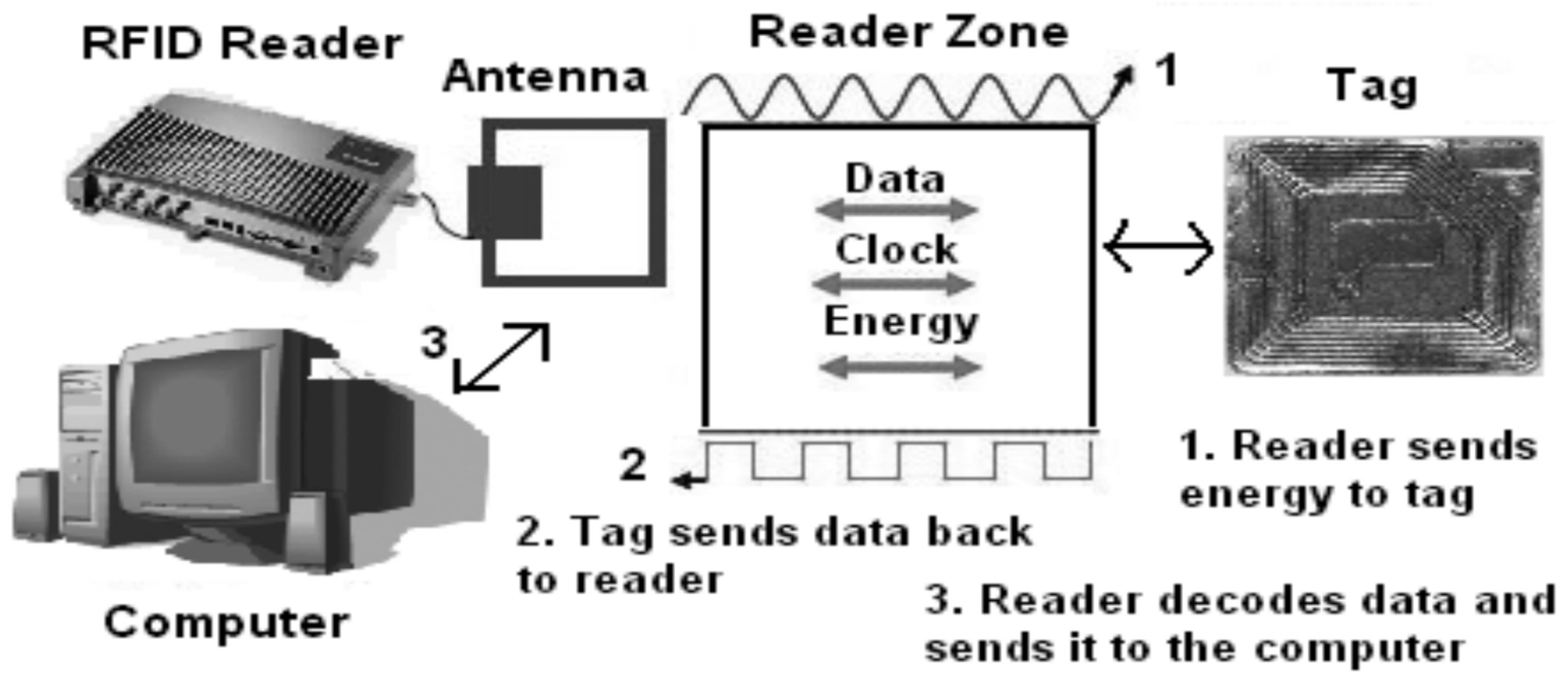
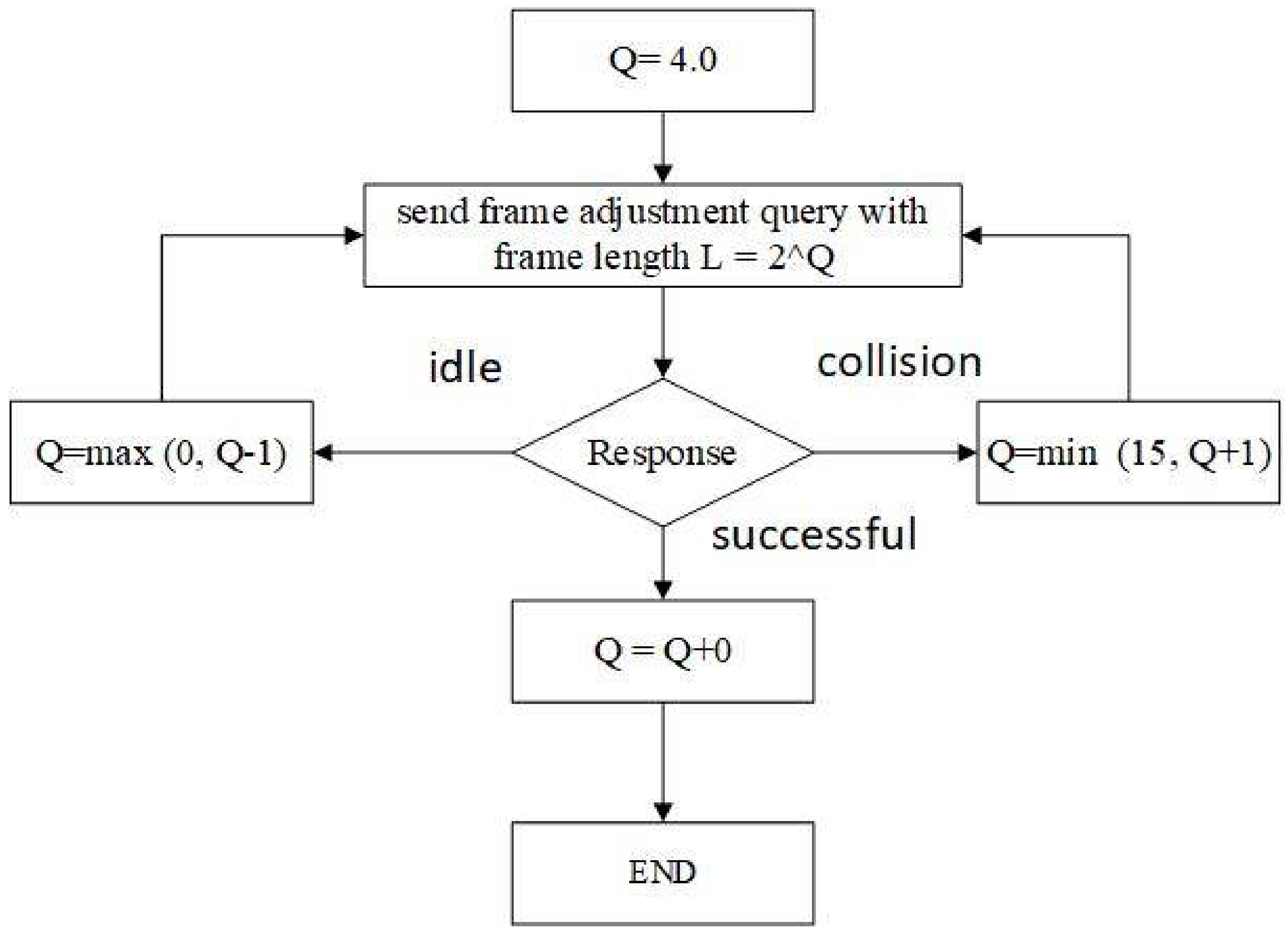
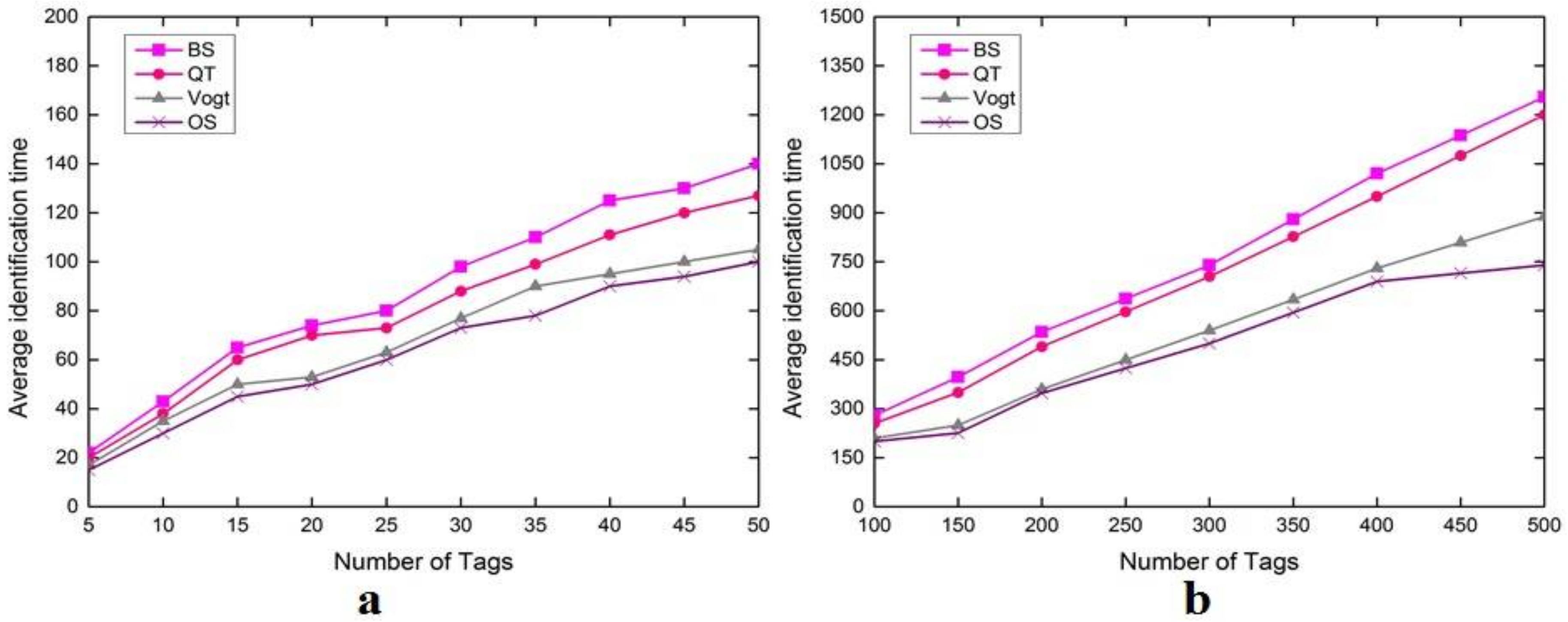
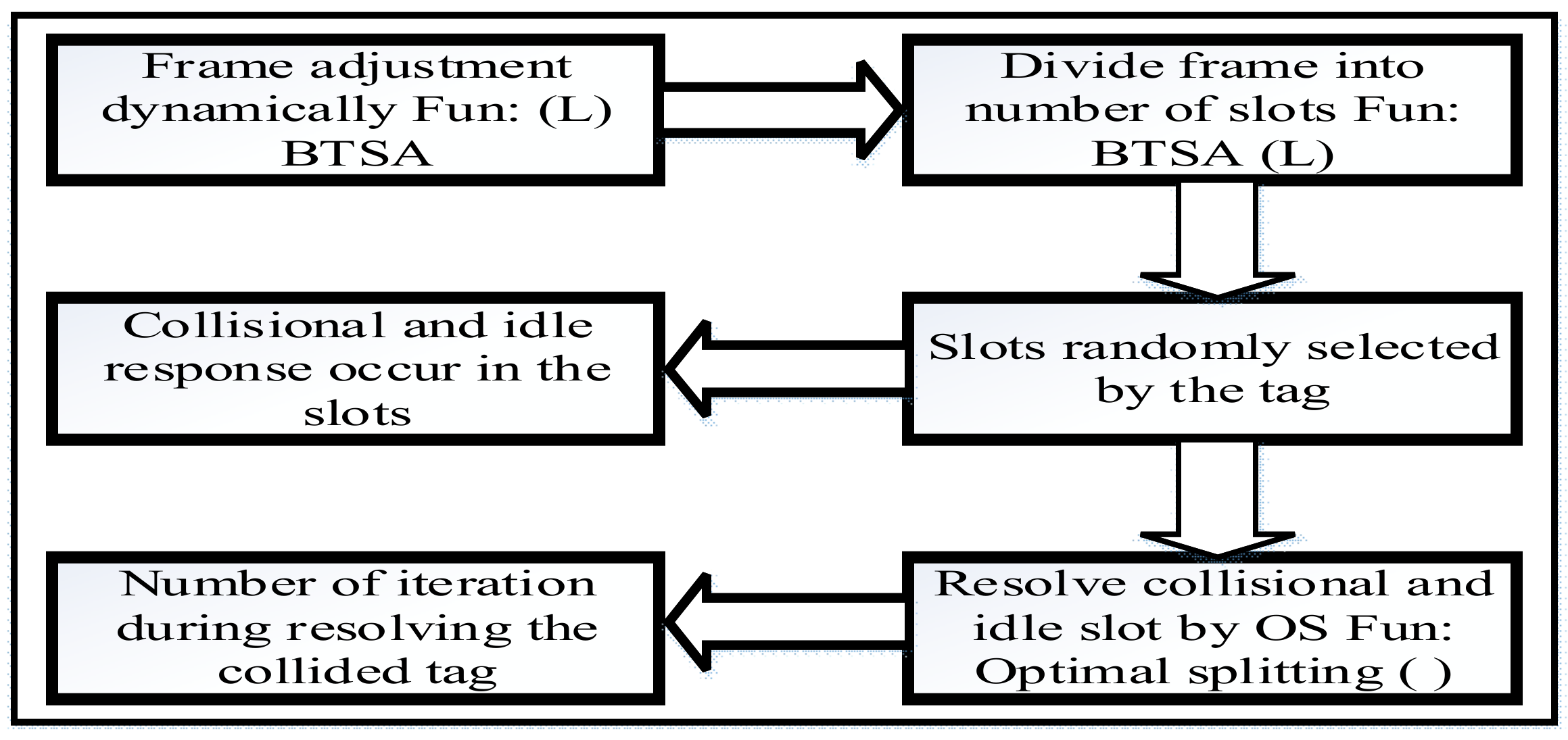
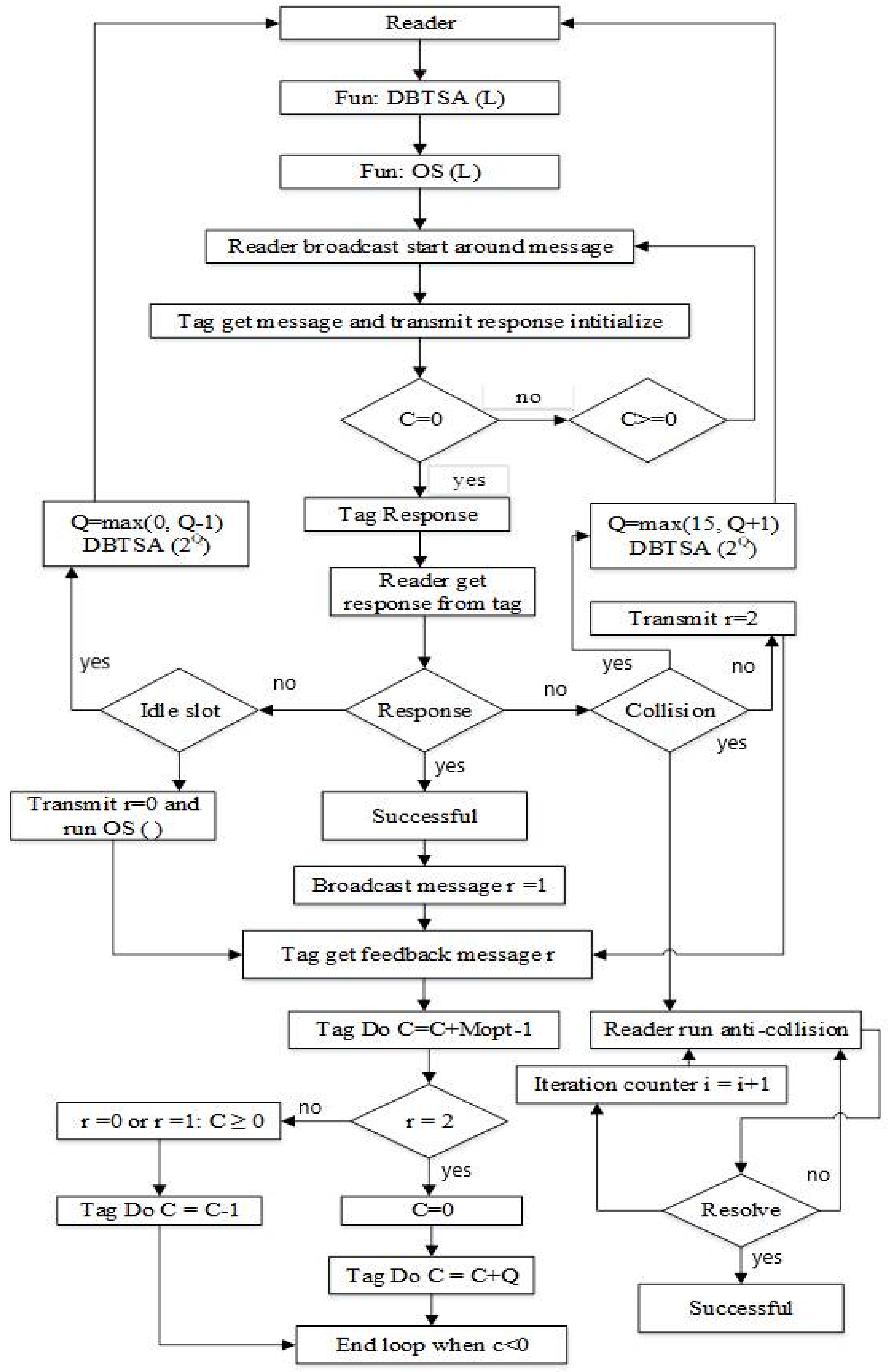
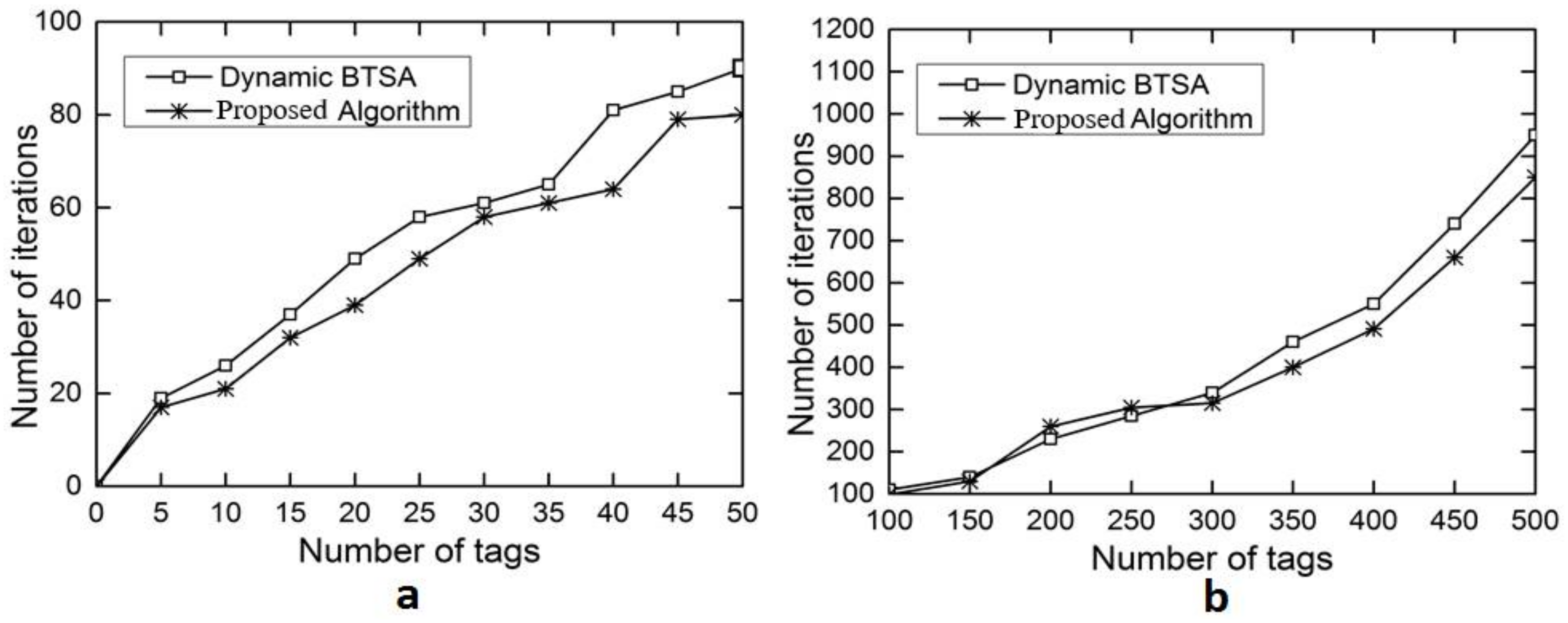


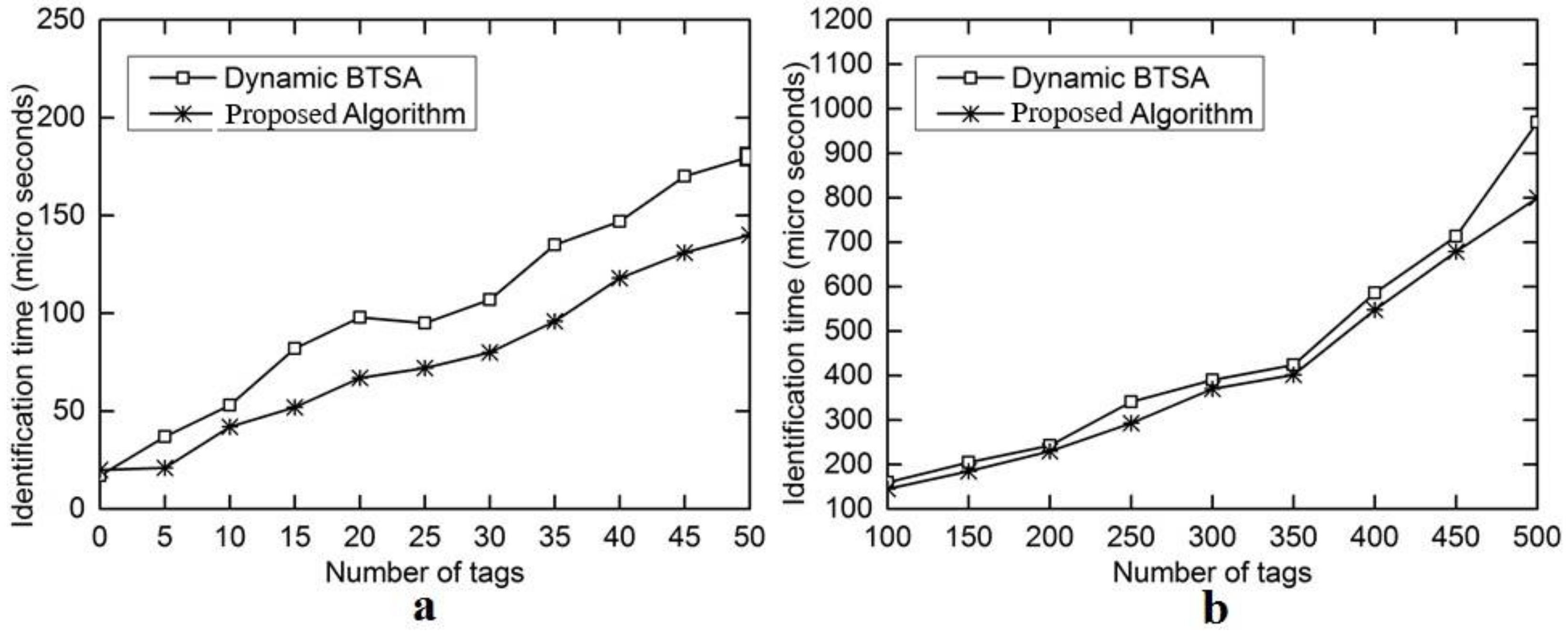

| Proposed Algorithm—Dynamic Binary Tree Slotted ALOHA (DBTSA) | |||||
|---|---|---|---|---|---|
| Number of Tags | Number of Idle Slots | Number of Collisions | Identification Time (Microseconds) | Number of Iterations | System Efficiency |
| 0–50 | 31–38 | 30–34 | 140–180 | 80–90 | 0.441–0.420 |
| 100–500 | 392–480 | 344–345 | 800–970 | 850–1050 | 0.411–0.400 |
© 2018 by the authors. Licensee MDPI, Basel, Switzerland. This article is an open access article distributed under the terms and conditions of the Creative Commons Attribution (CC BY) license (http://creativecommons.org/licenses/by/4.0/).
Share and Cite
Memon, M.Q.; He, J.; Yasir, M.A.; Memon, A. Improving Efficiency of Passive RFID Tag Anti-Collision Protocol Using Dynamic Frame Adjustment and Optimal Splitting. Sensors 2018, 18, 1185. https://doi.org/10.3390/s18041185
Memon MQ, He J, Yasir MA, Memon A. Improving Efficiency of Passive RFID Tag Anti-Collision Protocol Using Dynamic Frame Adjustment and Optimal Splitting. Sensors. 2018; 18(4):1185. https://doi.org/10.3390/s18041185
Chicago/Turabian StyleMemon, Muhammad Qasim, Jingsha He, Mirza Ammar Yasir, and Aasma Memon. 2018. "Improving Efficiency of Passive RFID Tag Anti-Collision Protocol Using Dynamic Frame Adjustment and Optimal Splitting" Sensors 18, no. 4: 1185. https://doi.org/10.3390/s18041185





